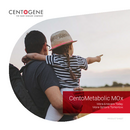CentoMetabolic MOx
More Answers Today. More Options Tomorrow.
Combining genetic and biochemical testing to deliver a quick and highly accurate multiomic diagnosis of rare metabolic disorders.
Metabolic Testing
Inherited metabolic disorders (IMDs) are life-long conditions and patients have a wide range of symptoms and needs. They are debilitating, with phenotypic, biochemical and genetic heterogeneity, frequently leading to prolonged diagnostic odysseys.
With a multiomic approach, we can help you and your patients accelerate the critical journey from symptoms to diagnosis by avoiding stepwise testing – saving time, resources, and pivotal years during which IMDs can rapidly progress.
CENTOGENE’s multiomic panel — CentoMetabolic MOx — has been designed to test for a wide range of IMDs — integrating genetic and biochemical testing in one single solution, for the fast and accurate diagnoses.
When genetic variants relevant to a patient are then detected via CentoMetabolic MOx, we automatically complement the analysis with biomarkers and/or enzyme testing if applicable, and include the results in the medical report. CentoMetabolic provides you with the most valuable information for diagnosis decisions, prognosis and therapeutic approaches, laying the roadmap to personalized treatment options.
Why Choose CentoMetabolic MOX?
Multiomic panel integrating genetic and biochemical testing in a single solution, for fast and accurate diagnosis of a wide range of inherited metabolic disorders
Biochemical testing to support variant classification, leading to higher diagnostic yields
Best-in-class medical reports powered by the world’s largest rare disease-centric Bio/Databank from the leader and trusted partner in rare disease diagnostics
Key Features and Performance
| Multiomic Approach | 206 genes and over 20 enzymes and biomarkers associated with more than 180 IMDs | ||||
|---|---|---|---|---|---|
| Coverage |
| ||||
| Improved Interpretation | Extra insights supported by our Bio/Databank, which contains curated unique variant data and omics data from a wide range of ethnicities from more than 120 countries, are used to confirm results and validate pathogenicity of the variants found | ||||
| Advanced and sensitive detection of sequence variants and deletions/duplications | Highly sensitive and specific detection of SNVs, InDels and CNVs
| ||||
| Material | CentoCard® (preferred) and blood | ||||
| TAT | 15 business days |
SNVs: single nucleotide variants; InDels: small insertions/deletions; CNVs: copy number variations
*CNV detection software has a sensitivity >95.0% for all homozygous/hemizygous deletions, as well as heterozygous deletions/duplications and homozygous/hemizygous duplications spanning at least three consecutive exons
**Variants with low quality and/or unclear zygosity are confirmed by orthogonal methods (i.e., SNVs and InDels by Sanger sequencing; CNVs by Multiplex ligation-dependent probe amplification, MPLA; quantitative polymerase chain reaction, qPCR; or chromosomal microarray, CMA)
Who Should Consider CentoMetabolic MOx?
Physicians providing diagnoses and treatments for patients matching any of the following criteria:
- Suspected metabolic disorder
- Overlapping symptoms and floppy babies
- Infants with lethargy, abdominal pain, vomiting, jaundice, metabolic acidosis
- Abnormal newborn screening results
- Developmental delay
- Infants admitted to a neonatal intensive care unit (NICU), especially due to epilepsy of unclear origin and disturbed consciousness
- Symptoms related to neurological conditions of unknown etiology
What Genes and Disorders Are Targeted?
CentoMetabolic targets close to 200 genes. The content and design of the panel is based on our continuously enhanced medical expertise and knowledge of rare metabolic disorders, including the latest medical and in-house findings.
The table below shows the distribution of genes and targeted metabolic disorders based on 18 different disease categories:
Types of metabolic disorders covered | Genes* |
|---|---|
| Congenital disorders of glycosylation and other disorders of protein modification | 2 |
| Defects in cholesterol and lipoprotein metabolism | 2 |
| Defects in hormone biogenesis or function | 7 |
| Disorder of phosphate, calcium and vitamin D metabolism | 3 |
| Disorders in the metabolism of purines, pyrimidines and nucleotides | 6 |
| Disorders in the metabolism of trace elements and metals | 6 |
| Disorders in the metabolism of vitamins and (non-protein) cofactors | 10 |
| Disorders of amino acid and peptide metabolism | 33 |
| Disorders of carbohydrate metabolism | 35 |
| Disorders of energy metabolism | 6 |
| Disorders of fatty acid and ketone body metabolism | 3 |
| Disorders of lipid and lipoprotein metabolism | 8 |
| Disorders of neurotransmitter metabolism | 1 |
| Disorders of porphyrin and heme metabolism | 8 |
| Disorders of the metabolism of sterols | 16 |
| Lysosomal disorders | 48 |
| Peroxisomal disorders | 16 |
| Porphyria and bilirubinemia | 1 |
*Due to overlapping phenotypes, particular genes are listed in more than one category as they are associated with more than one disorder
Going Beyond Genetics – What Biomarkers and Enzymatic assays are included?
CentoMetabolic MOx panel includes biomarkers and enzymatic assays 18 metabolic disorders. Biomarkers serve as measurable indicators of pathological processes. They are typically directly linked to genetic variants in specific genes and can predict, diagnose, monitor, and assess the severity of a disease. Measuring the cellular activity of an enzyme can also be used as a tool for the diagnosis and monitoring of a disease, as well as treatment efficacy.
Our multiomic- and big data-based approaches allow us to continuously discover new highly specific biomarkers and develop new enzymatic assays. Any new biomarker and biochemical assay clinicaly relevant for metabolic disorders will be included in this panel, and represents an opportunity to advance our understanding of metabolic disorders well as develop better tailored therapies for patients.
Resources
Quick Links
Downloads

CentoMetabolic MOx – Product Sheet
More answers today. More options tomorrow.
Scientific Publications
Improving Diagnostic Options for Rare Diseases
A diagnostic strategy for rare diseases based on a combination of standard laboratory parameters has long been sought after. To help advance this approach, CENTOGENE actively participates in […]
Turning Rare Disease Networks into Knowledge
CENTOGENE’s well-recognized expertise in Gaucher disease (GD) has helped to establish a global network of physicians interested in and aware of this rare metabolic disorder. The fact that CENTOGENE […]
Large Patient Cohort Enables Insights into a Rare Disease
Farber disease (FD) is a severe disorder for which rarity has hampered a comprehensive understanding. A recent study on a large cohort of patients provides unprecedented novel insights into FD. The […]
Enzymes and Biomarkers Included in MOx Products
Enzyme assays and biomarkers included in CentoMetabolic MOx products and corresponding diseases
Enzymes
Oligosaccharidoses and Sphingolipidoses
-
Wolman disease
Acid lipase -
Pompe disease
Alpha-glucosidase -
Fucosidosis
Alpha-fucosidase -
Fabry disease
Alpha-galactosidase - Schindler/Kanzaki disease
Alpha-N-acetylgalactosaminidase - Gaucher disease
Beta-glucocerebrosidase - Tay-Sachs disease
Beta-hexosaminidase - Beta-mannosidosis
Beta-mannosidase - Sandhoff disease
Total-hexosaminidase
Enzymes
Neuronal Ceroid Lipofuscinosis
-
Santavuori-Haltia disease
Palmitoyl-protein- thioesterase - Jansky-Bielschowsky disease
Tripeptidyl-peptidase
Enzymes
Mucopolysaccharidosis
- Hurler syndrome (MPS I)
Alpha-L-iduronidase - Hunter syndrome (MPS II)
Iduronate-2-sulfatase - Sanfilippo syndrome B (MPS III B)
Alpha-N-acetylglucosaminidase - Morquio syndrome B (MPS IV B)
Beta-galactosidase - Maroteaux-Lamy syndrome (MPS VI)
Arylsulfatase B - Sly syndrome (MPS VII)
Beta-glucuronidase
Biomarkers
- Gaucher disease
Glucosylsphingosine (lyso-Gb1)* - Fabry disease
Lyso-ceramide trihexoside (lyso-Gb3)) - Niemann-Pick disease type A/B/C
Lyso-SM-509 - Aromatic L-amino acid decarboxylase (AADC) deficiency
3-O-methyldopa (3-OMD)
*A method using Lyso-Gb1 is covered by US Patent No.10,859,580, other pending US applications, and pending applications and patents in other jurisdictions
MOx 2.0
Beyond Diagnostics.
Explore the paradigm shift with CENTOGENE’s integrated multiomic solution – now including RNA sequencing!
Related Webinars
Multiomics and Biomarkers in Rare Diseases Supporting Development and Commercialization of Orphan Drugs
Watch our webinar to learn about innovative methods to tackle the challenges of orphan drugs in early stage development, clinical trial enrollment, and market development.
Biomarcadores: acelerando diagnósticos y guiando tratamientos
Mira nuestro webinar sobre biomarcadores, donde discutiremos un enfoque multiómico, que combina información sobre la genómica, la proteómica y la metabolómica, para acelerar la interpretación de los […]
Biomarkers: Accelerating Diagnoses and Guiding Treatments
Watch our webinar, where Prof. Peter Bauer, MD discusses a multiomic approach to accelerate the interpretation of data and the development of life-changing biomarkers for rare diseases. Throughout […]
Get in Touch With Our Customer Support
Our consultation service is available in several languages.
+49 (0) 381 80 113 - 416
Mon. – Fri. 7 a.m. – 6:30 p.m. CET
Sat. 8 a.m. – 12 p.m. CET


